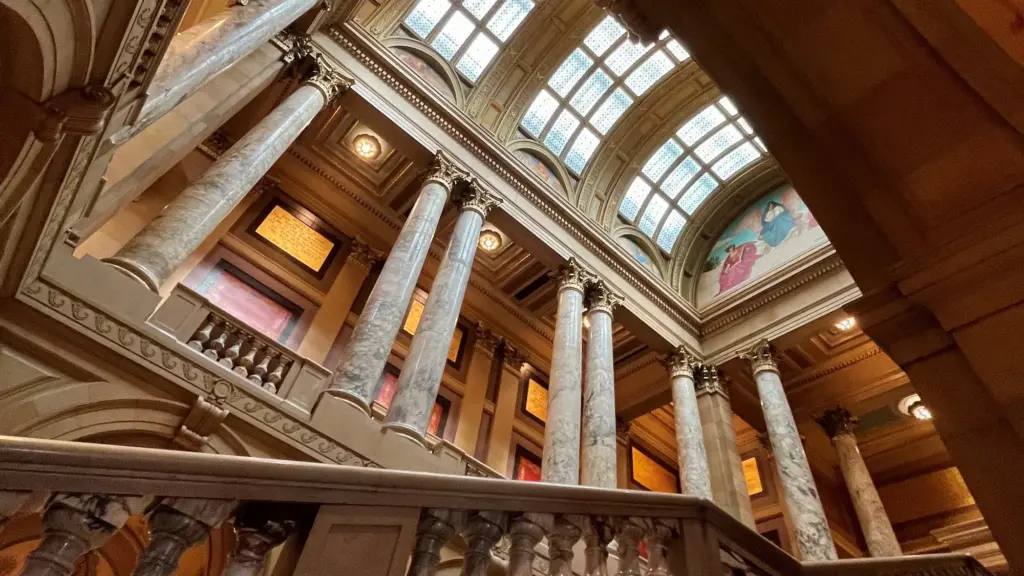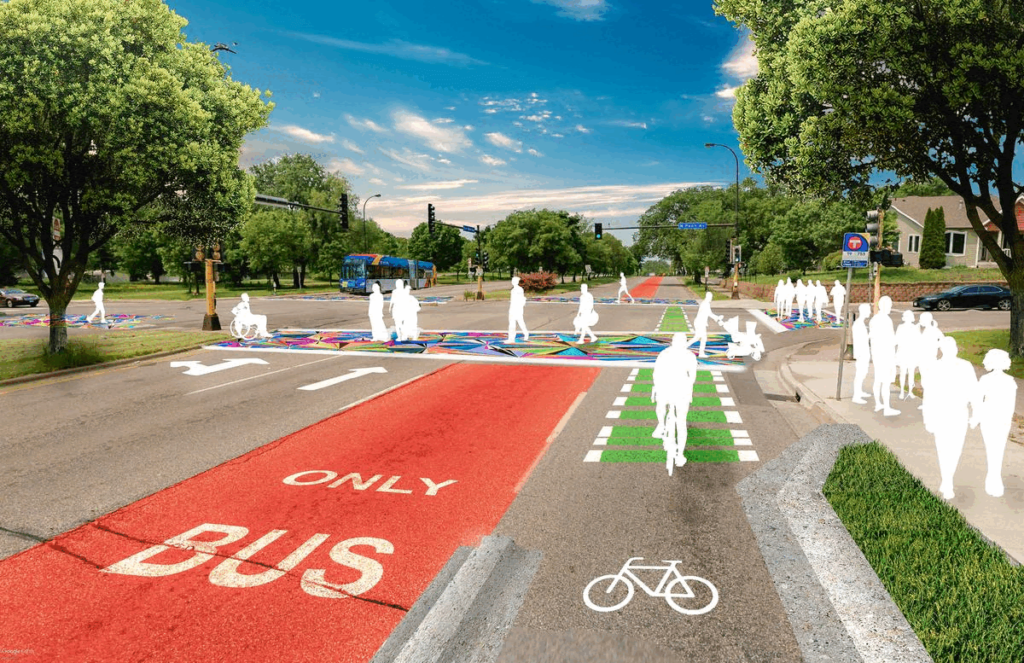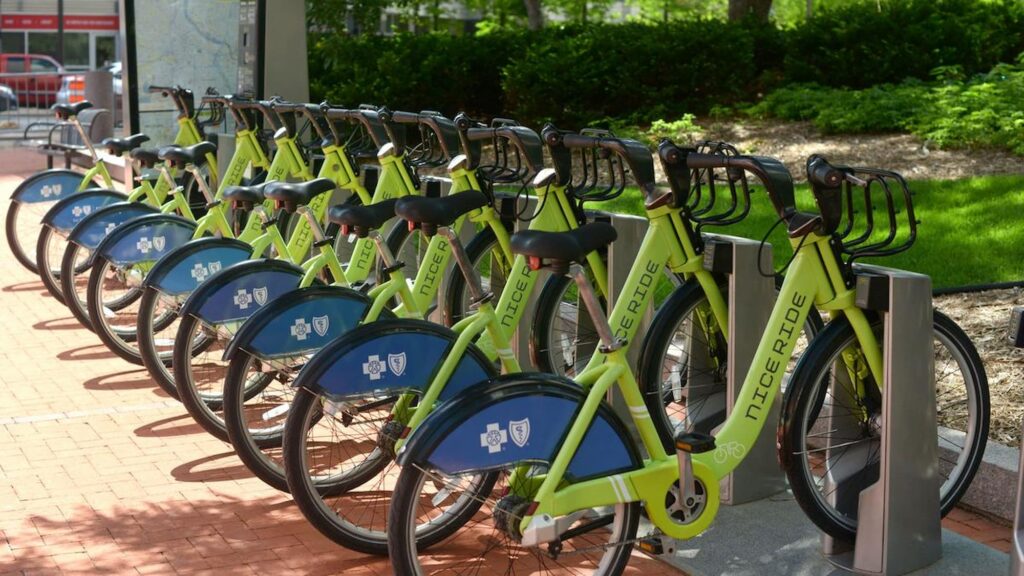
The 2023 state legislative session is underway in Saint Paul and is scheduled to conclude in May. This session is a critical opportunity to pass legislation that supports a people-first transportation system that prioritizes climate, racial, and economic justice.

This legislative session will have a big impact on Our Streets Minneapolis advocacy campaigns, particularly those in which the Minnesota Department of Transportation (MnDOT) is the primary decision maker. These include Bring Back 6th and the Twin Cities Boulevard.
The state also has an abundance of resources to allocate, including the projected $17.6 billion budget surplus and hundreds of millions in federal infrastructure dollars via the Infrastructure Investment and Jobs Act (IIJA) and Inflation Reduction Act (IRA). These funds represent a critically important choice for Governor Walz and state legislators. They can either be invested in people-centered infrastructure that repairs historic and ongoing harms or fund endless highway expansion that worsens the climate crisis and cements environmental injustice.
Over the coming weeks, Our Streets Minneapolis will be organizing community members to support the below legislative priorities: Twin Cities Boulevard, Bring Back 6th, Statewide Transportation Reforms, and continued support of other legislative efforts like Nice Ride funding.
TWIN CITIES BOULEVARD

Legislation to commission a feasibility study of an I-94 highway-to-boulevard conversion.
We are calling on legislators to commission a feasibility study to holistically evaluate converting I-94 into an urban boulevard between downtown Minneapolis and Saint Paul.
Now is a critical time to study the Twin Cities Boulevard to ensure that it receives fair consideration as future planning for the I-94 corridor, via MnDOT’s Rethinking I-94 project, moves forward. Initial project alternatives (a.k.a the designs that will be studied) will be unveiled this year. The Rethinking I-94 project will determine the future of the highway for the next half century.
While MnDOT has said that they will study a boulevard conversion as part of the Rethinking I-94 project’s alternatives analysis, that is insufficient. The Environmental Impact Statement (EIS) process limits what can be studied and fails to fully consider the intersectional impacts of highways. MnDOT’s process also uses biased assumptions that prioritize car and truck traffic, minimize community and environmental impacts, and do not account for induced demand or traffic evaporation.
A feasibility study would help the public and decision makers better understand how a future without the freeway could work and the expected impacts on:
- Transportation access, traffic, and freight movement
- Greenhouse gas emissions, air & noise pollution, environmental justice and racial equity
- Economic opportunity and housing access
- Tax revenue and regional land use
- Traffic safety and public health
Similar studies have been funded in past omnibus transportation bills, often focused on evaluating highway expansion or suburban transit projects. This is an important opportunity to further explore a solution for repairing I-94’s harms and investing in reparative justice for surrounding communities.
A study would also put the state in a strong position to seek additional federal funding through the Infrastructure Investment and Jobs Act’s Reconnecting Communities Pilot Program and the Inflation Reduction Act’s Neighborhood Equity and Access Grants Program.
BRING BACK 6TH

Legislation to lower the Olson Memorial Highway speed limit to 25 MPH, fund near-term safety improvements and study the restoration of 6th Avenue N.
Currently, the speed limit on Olson Memorial Highway within Minneapolis is 40 miles-per-hour (MPH). However, the highway’s wide traffic lanes and limited crossings encourage drivers to travel even faster. This has created unsafe conditions for all users. A lower speed limit is long overdue. Olson Memorial Highway is a high-injury street and residents have asked the City to make safety improvements for years. This includes through the feedback process for the City’s Vision Zero initiative.
A lower speed limit would immediately save lives. Just 15% of people who are hit by a car traveling at 40 MPH survive the crash. The survival rate jumps to 95% if the car is traveling 20 MPH.
A speed limit of 25 MPH would make Olson Memorial Highway consistent with other City streets. Simply lowering the speed limit is not enough. Changes to the street design are needed to slow vehicle speeds and create safer outcomes.
A lower speed limit would be an important first step toward an improved street design. The high speed limit on Olson Memorial Highway has been used by both MnDOT and Minneapolis Public Works as a reason why critical safety and multimodal improvements, like more crossings, narrower lanes, and a protected bike lane, cannot be implemented. A lower speed limit is a catalyst that would make the future implementation of these improvements possible.
In addition to lower speed limits, we are asking legislators to allocate funding to implement safety improvements on Olson Memorial Highway and to study the removal of the highway and restoration of 6th Avenue North.
STATE TRANSPORTATION REFORMS
Legislation, such as the “Sustainable Transportation Act”, that sets a statewide VMT reduction goal and requires the state to prioritize climate and equity in major transportation projects.

On a higher level, there is also a need to reform the state’s transportation planning process and set clear goals for climate action, racial equity and environmental justice.
Transportation is Minnesota’s biggest greenhouse gas emissions sector, and urgent action is needed to avert the worst consequences of climate change. While rapid electrification is vital, the fact is that it is not enough to achieve necessary emissions reductions. Analysis by the Rocky Mountain Institute shows that the United States needs to reduce driving, as measured by “vehicle miles traveled” or “VMT”, by 20 percent before the end of this decade in order to maintain a path to limit warming to 1.5°C.
Despite the urgent need to act, the Minnesota Department of Transportation (MnDOT) continues to prioritize expanding highways instead of investing in walking, biking and mass transit options. This has disproportionately harmed BIPOC, low-income, and disabled communities, who statistically have less access to cars; rely on walking, biking and transit more; and live in neighborhoods near highways and busy roadways with higher levels of traffic pollution.
Leadership is needed at the state level to set a statewide VMT reduction target and hold state agencies like MnDOT accountable. During the 2021 legislative session, the Sustainable Transportation Act was introduced by House Transportation Committee Chair Frank Hornstein. The bill included a goal to reduce statewide VMT 20% by 2050 and required MnDOT to establish a baseline measurement, create region specific goals, incorporate the goal into project planning, and regularly update the public about the agency’s progress. It also included additional requirements for electric vehicle charging and transit fleet electrification. Unfortunately, the bill stalled in the Senate.
The 2023 legislative session is an important opportunity to pass an even stronger bill that will make Minnesota a leader in sustainable and equitable transportation.
This includes:
- Setting a statewide VMT reduction goal of 20% by 2030.
While the introduction of a VMT reduction goal was an important step, the fact is that a 20% reduction by 2050 would be too little, too late. We are calling for a VMT reduction goal that is aligned with climate science and the urgent need for action.
- Adopts requirements to prioritize climate, equity and environmental justice in major transportation projects. This should include requirements for MnDOT and metropolitan planning organizations (MPOs) to:
- Quantify the total greenhouse gas emissions expected from future transportation projects and to reduce emissions by set amounts over time
- Evaluate transportation plans to determine their effect on marginalized communities
- Account for induced demand and traffic evaporation in their travel modeling
In order to make meaningful progress on climate, racial equity, and environmental justice, they must be prioritized throughout the planning and design process. Unfortunately, that is not currently the case in Minnesota. MnDOT’s existing planning process prioritizes pavement condition and traffic speed above all else and includes very few requirements to consider the impacts on climate, public health and the people who have been disproportionately impacted.
While the Minnesota Environmental Quality Board recently started requiring a greenhouse gas emissions analysis for major highway projects, this analysis is for “disclosure purposes only” and does not directly impact the alternative selection process.
Other states have recently passed laws that require climate and environmental justice to be prioritized when planning and funding major transportation investments and provide a model for Minnesota to follow. New rules in Colorado reformed the state’s transportation planning process and aim to “reduce greenhouse gas emissions from the transportation sector, improve air quality, reduce smog and provide more travel options.”
The policy has already resulted in major progress, including the cancellation of two highway expansion projects with the funds being reallocated to public transit. In the next 30 years, CDOT expects the new rules to shift $6.7 billion away from highways and towards people-centered projects that reduce driving and expand access to walking, biking, and transit.
The 2023 legislation session is the opportunity for Minnesota to follow Colorado’s lead and reform the state’s transportation planning process to prioritize climate and environmental justice.

Additional legislative efforts that we will continue to support:
- State funding to save the Nice Ride bike share system in 2023.
Last year, Nice Ride lost its primary sponsorship from Blue Cross Blue Shield and is now facing a nearly $2 million funding gap. Without funding for the state this legislative session to support the system while a new sponsor is secured, the Nice Ride bike share system will close or be significantly scaled back. Click here to contact legislators about this issue. - Increased, dedicated funding to expand pedestrian, bicycle and transit infrastructure across the state.
This includes a proposed 1 cent dedicated regional sales tax to fund transit operations and system expansion in the Twin Cities. A 2022 statewide poll conducted by Data for Progress found that 66% of respondents would support legislation that expands opportunities for public transportation, reduces pollution from Minnesota roadways and creates alternatives to using personal vehicles. - A fix-it first policy for road spending.
This would require MnDOT to repair its existing roads and bridges before spending transportation dollars on highway expansion. - The Freedom to Drive movement to provide driver’s licenses and state ID’s to all Minnesotans, regardless of immigration status.
- Fare enforcement reform and the creation of a transit ambassadors program.
- Passing the Bill Dooley Bicycle Safety Act.
This bill is named after a beloved transportation advocate who passed away last year. It would significantly increase funding for pedestrian and bicycle infrastructure, including the Safe Routes to School program, and would enact many common sense policy reforms, including the legalization of the “Idaho stop”. - A constitutional amendment that would enable gas tax dollars to be spent on transit and active transportation infrastructure.
Currently, these funds are constitutionally dedicated to roads and bridges and are primarily spent on highways. - State funding to pilot and implement zero-fare transit service.
Key Legislative Committees
These bills and all legislation that pertains to transportation issues must pass through the House and Senate transportation committees. Below are the committee web pages, chairs, and meeting information. In addition to contact your legislators, reaching out to the committee chairs helps to ensure that these issues will receive a hearing and have an opportunity to pass this session.
| House Transportation Finance and Policy Committee Committee Chair: Representative Frank Hornstein Meeting time & location: Tuesdays and Thursdays @ 8:30 a.m. in Room #120 of the State Capitol | Senate Transportation Committee Committee Chair: Senator Scott Dibble Meeting time & location: Monday and Wednesday 3:00 – 5:00 p.m. in Room 1100 of the Minnesota Senate Building |